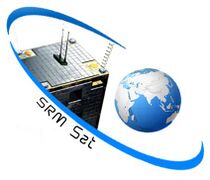Engineering:SRMSAT
| Mission type | Technology |
|---|---|
| Operator | SRM Institute of Science and Technology |
| COSPAR ID | 2011-058D |
| Website | www |
| Mission duration | 12 months (planned) 12 years, 9 months, 9 days (in progress) |
| Spacecraft properties | |
| Launch mass | 10 kilograms (22 lb) |
| Start of mission | |
| Launch date | 12 October 2011 |
| Rocket | PSLV C18 |
| Launch site | Satish Dhawan FLP |
| Orbital parameters | |
| Reference system | Geocentric |
| Regime | Low Earth |
| Inclination | 20 degrees |
| Period | 102.1 minutes |

| |
SRMSAT is a Nanosatellite built by students at Sri Ramaswamy Memorial University (SRM Institute of Science and Technology, Chennai) in India . The satellite is an Indian Technology demonstration and Earth observation satellite which is operated by the SRM Institute of Science and Technology. This nanosatellite was used to monitor Greenhouse gases in atmosphere.
SRMSAT's primary mission was the development of a nanosatellite platform for future missions. Its secondary mission was monitoring of greenhouse gasses[1] using an Argus Spectrometer.[2]
Specifications
- It is a 10.4-kilogram (23 lb) spacecraft, which measures 28 centimetres (11 in) in length by 28 centimetres (11 in) in height and width.
- Its development programme cost around 1.5 crore rupee.
- It had a design life of one year, but is still working (As of October 2017) and can be tracked easily on n2yo.com [3]
Launch
It was launched from the Indian Space Research Organisation (ISRO)'s Satish Dhawan Space Centre at Sriharikota in October 2011.[4] atop a Polar Satellite Launch Vehicle (PSLV) C18 rocket. The launch was a multi-payload mission shared with Megha-Tropiques, VesselSat-1 and Jugnu.[5]
Parameters
See also
- 2011 in spaceflight
References
- ↑ "TN university plans centre for space technology". The Times of India. http://articles.timesofindia.indiatimes.com/2011-10-11/chennai/30266441_1_srm-university-nano-satellite-ground-station.
- ↑ "Argus Infrared Spectrometers". Thoth Technology Inc.. http://thoth.ca/spectrometers.htm.
- ↑ "LIVE REAL TIME SATELLITE TRACKING AND PREDICTIONS: SRMSAT". N2YO.com - Real Time Satellite Tracking and Predictions. http://www.n2yo.com/?s=37841.
- ↑ "PSLV-C18 carrying weather satellite launched". Times Of India. http://timesofindia.indiatimes.com/india/PSLV-C18-carrying-weather-satellite-launched/articleshow/10323961.cms.
- ↑ Subramanian, T. S. (12 October 2011). "PSLV-C18 puts four satellites in orbit". The Hindu. http://www.thehindu.com/news/national/article2530847.ece.
External links
 |


